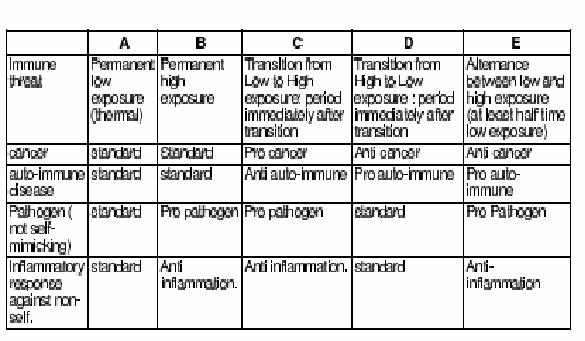
Using U.K., U.S. and Dutch Data to test a brand new French theory of Cancer and establishing the link between RF reduced melatonin and cancer by Dr Chris Barnes, Bangor Scientific and Educational Consultants e-mail doctor.barnes@yahoo.co.uk
Dr Barnes Homepage http://www.drchrisbarnes.co.uk
Abstract
Brief commonly accepted reasons for cancer are summarised. RF (radio frequency) radiation as an unlikely cause or promoter of cancer is introduced as is Lauer's quantum immunology hypothesis and its relationships with RF radiation and the predications it makes and in terms of different types of radio modulation schemes. Sets of Data form Cancer Research UK, the Dutch Cancer Registry and SEER the U.S. Registry are compared in the context of Lauer's theory. Seeing that Lauer's predictions appear to be set against a rising background for the UK and Dutch data leads to both an explanation in terms of the differences between the digital TV system in the U.S and Europe and serum melatonin. The European system appears to be pro-cancer whereas the US is cancer neutral. TETRA base stations despite all the bad publicity actually appear to be anti-cancer. The work to some extent supports Lauer's hypothesis the changes in the makeup of the background RF radiation field alter cancer rates in a highly predictive manner due to influence on the immune system, particularly T-cell -APC binding. The work also establishes an almost incontrovertible argument for the effect of RF on the pineal gland hence reducing serum melatonin levels and promoting cancer. As RF technologies saturate then so do cancer rates, at least the work establishes that cancer rates will not carry on increasing indefinitely, Thus countries will be better able to budget for expected diagnosis numbers and treatment plans. The three countries of this study propose further changes in their use of RF technology, 4G, for example, thus further transient changes in cancer rates are to be expected as a result. Vitamin D status for the Leukaemia trend has only a minimal effect, say 10% compared with other background changes induced by RF radiation as a cancer promoter.
Introduction
Nuclear radiation, chemical environmental pollution, one’s genetic makeup and simply aging, just ask any well informed lay person and they will be sure to tell you the reasons for cancer and its incidence. Gone are the days when only one’s GP or consultant would have such insight.
But what if there were another type of pollution capable of causing increased cancer incidence and what if doctors and oncologists were aware of it but chose to ignore or dismiss it either because they didn’t understand its mechanism because national and international advisors told them that the technologies which caused such pollution were either entirely safe or on the balance of probability ‘safe’, where for instance the balance of probability had been determined by a very large number of experiments most of which were not wholly reproducible.
What if this type of pollution pervaded all space, something for instance cigarette smoke by comparison is no longer permitted to do? What if this pollution were called electromagnetic radiation and what if you were told it won’t harm you unless it heats you up and burns you, so called thermal effects. And, of course it is non-ionising so it can’t break chemical bonds and disrupt your DNA.
Then surely you would probably be persuaded of its safety?
But what if there was a convincing body of epidemiological evidence and geographic meta-analysis to suggest danger? Then maybe, if RF technologies didn’t make the world go around, and weren’t multi-billion dollar industries in 50 years time you might just sit up and listen?
This paper asks what will you do, what will we all do, when there is a testable hypothesis now provided by Lauer (1) directly showing the action of RF energy on the immune system and further testable by this paper which independently tests the validity of Lauer’s and a number of other related hypotheses ?
Lauer’s hypothesis RF energy and quantum biology of T cells in the immune system
Lauer’s hypothesis is by no means easy to understand but because something appears complicated does not mean it is inherently wrong or invalid. Houghton and Guevara-Patino 2004 (2) provide a useful explanation of the crucial role which T-cells play in rejecting tumours. A multi-step recognition process takes place during the interaction of a T-cell with an APC (Antigen Presenting Cell). In the first step the CD8 co-receptor molecule binds to the MHC (Major Histo-compatibility molecule). Then, secondly TCR binds to MHC. Finally recognition occurs (step 3 TCR-pMHC) where MHC has hyper-variable regions alpha and beta very specific to one peptide ‘p’. The various stages of binding can each be regarded as having quantum wells with appropriate energy barriers in between. Binding must occur for a certain minima time for the T-CELL to be able to kill the APC. Lauer is by no mean the first to discuss quantum effects in cancer, for instance impairment of quantum coherence and/or entanglement among microtubules has been discussed previously by Hameroff (2004). Lauer also briefly mentions the possibility of quantum mechanical perturbation during DNA replication but this is not the main focus of his work.
From Lauer (1) , it is clear that thermal energy can govern transitions between wells or the transitions can be modulated by external RF energy. The theory of Lauer is developed to show how RF energy with appropriate modulation bandwidths can reduce the APC destruction probability hence influencing the immune system and inter-alia cancers. Typical minimum interaction energies are minute and of the order of 10^-10 w/m^2 in other words so called subtle field interactions.
The predictions made by Lauer’s hypothesis are summarised in the table below:

Figure 1
The somewhat surprising and almost counter-intuitive predictive upshot of the above is that effects of changes in the RF environment are transitory. According to Lauer, this is connected with the way in which the body and thymus in particular manufactures and stores different populations of T-cells.
Lauer states that this may explain increased local cancer rates when, for instance, a new mobile phone installation is opened. The effects are also dependent on the bandwidth of the RF emissions involved and their pulse repetition rates. Lauer's theory suggests that an RF emission broad flat topped power bandwidth spectrum such as DVB(T), which produces such a spectrum because of a very complex modulation scheme. DVB-T is a multi-carrier system USING about 2000 or about 8000 carriers, each of which carries QPSK, 16QAM or 64QAM. QAM (Quadrature Amplitude Modulation) is one of the means which is used to increase the amount of information per modulation symbol. Taking the example of 64QAM, the hierarchical system maps the data onto 64QAM in such a way that there is effectively a QPSK stream buried within the 64QAM stream. Further, the spacing between constellation states can be adjusted to protect the QPSK (HP) stream, at the expense of the 64QAM (LP) stream.
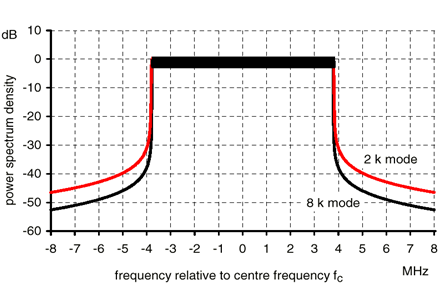
Theoretical Power Bandwidth Spectrum of a DVB signal
In order to understand how Lauer's theory works an in-depth knowledge of quantum mechanics and advanced mathematics is required for example, Rabi integration. However, another less challenging way, and suggested here by the present author, may be to think of the molecular dynamics of complex biological binding processes of leading to a large number of modes of spatial orientation and protein chain conformation. The more frequencies present in the incoming signal to cause dielectric and/or vibration interaction the more chance of disturbing the process. Also the more chance these frequencies have of coinciding with or disturbing biologically coherent signals see also Smith and Best (3) ISBN 0-460-86044-5) , compared say with just a single carrier RF carrier wave.
Lauer(1) used detailed death registry information for various French towns and cities to consistently validate his hypothesis so impressively so the present author believes it is sufficient to deem it a theory.
As with any very complex piece of work there are bound to be minor holes and inconsistencies. For example radio emissions other than FM, TV and DVBT are not considered. For example it is possible that in some of these towns and cities emissions such as Tetrapol and Paging transmitters and WIFI hotspots may have been providing significant or even dominant additional field strength. Lauer also makes much play on the age range 25-44 as being the range where death rates have most fallen due to intermittent exposure to GSM. This is of course also the age range where most men have quit smoking in the UK (4) and presumably the statistic for France may be similar?
Testing Lauer’s theory
The present author has already produced a considerable body of epidemiological work, review work and theoretical work with regard to RF radiation and cancer in the UK and Worldwide. It ought to be quite easy therefore to check with available data if any of the transient, predictable effects of Lauer do indeed occur here in the UK. The prediction is that if the dominant or exclusive mode of interaction of RF with tissue is in accord with Lauer then cancer rates should be seen to transiently rise and fall about some mean in accordance with the introduction of and penetration of each new RF technology. Furthermore there ought to be discernible differences on the transients according to the bandwidths and pulse repetition rates of the particular technology in use. Theoretically an emission with a slow enough pulse repetition rate might even be expected to simulate the effect in Table 1 column E. In various French towns and cities, Lauer (1) notices changes in local death rates some 450 days after new DVBT transmitters come into play. One might conclude that these deaths could be due to cancers with very short latency periods such as, for example, Leukaemia or NHL (Non-Hodgkin Lymphoma). Fortunately, the present author has previously accurately determined the latency periods of 17 common cancers (5).
There is no need here to display large data sets, since the present author has recently explored changes in cancer rates as a function of RF technology in the UK just prior to the release of Lauer’s paper. Neither the time evolution of death rates nor incidence rates is absolutely ideal for such types of evaluation because death rates compared over time can fall artificially due to better and improved treatments and because incidence rates can appear to rise artificially due to improved diagnosis. In Britain a lot of publicity has led to improved diagnosis of breast, bowel and prostate cancer and one might expect this to be reflected in more quickly rising incidence rates then say adult Leukaemia for example. Lung cancer incidence rates had been falling particularly amongst males and those individuals that have either not taken up smoking or who have quit. However a recent UK TV campaign on the dangers of the persistent cough may possibly have reversed that trend.
Due to the above, it is possible thus that the effects of Lauer (1) may appear as super-imposed rather than on a flat line rate but instead on an indigence trend line of increasing slope. It ought to be possible to mathematically model longer term incidence rate trend lines and make future predictions. If the rate is predicted to carry on increasing then one has to search for an additional mechanism over and above that of Lauer. There are of course no shortages of proposed mechanisms but few have to date been wholly or independently testable.
Although Lauer (1) has highlighted the influence of the immune system, the present author feels it should be borne in mind that there is another potential mechanism of RF interaction which could indirectly affect the immune system. This is the influence of RF radiation on the pineal gland and its influence on circadian melatonin levels. There is no question that the pineal gland has been proven to be field sensitive (6-12). It should be noted that these are but a few of the very large number of references in this research area.
Results
Using data for some common cancers taken from the ‘Cancer Research UK’ website and mapping changes against known changes in the Radio Frequency Emissions background in the UK, the following results table is deduced.
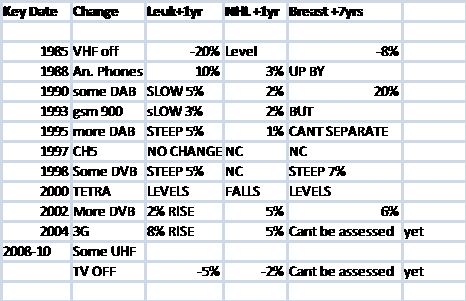
Table 1
These results are superimposed on the following approximate slopes in trend lines since 1975. Leukaemia 1.5; NHL 3.0; Breast Cancer 5.5 and Prostate Cancer 3. There have been large drives to screen for Breast Cancer and better rates of diagnosis, see below
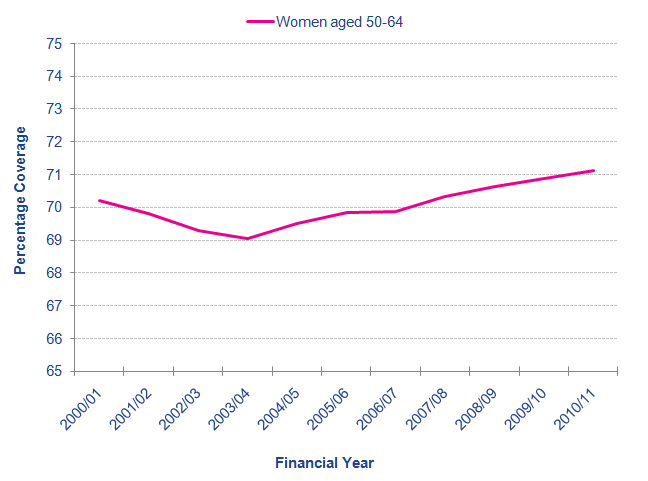
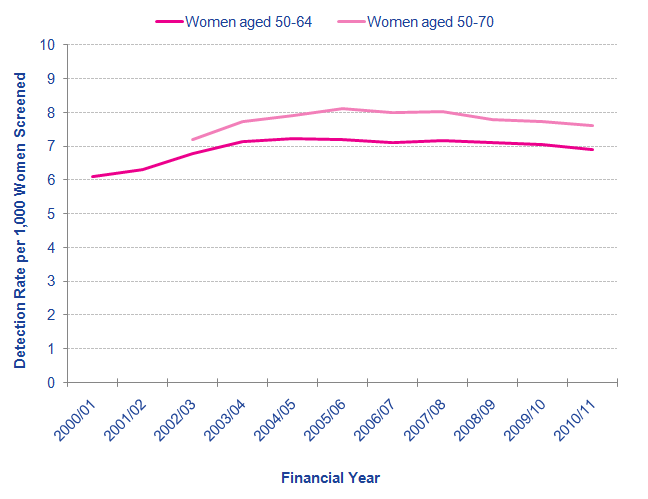
Figure 1
This possibly inflates the slope in the incidence trend line compared with the other cancers considered. Britain was of course affected by Chernobyl but although a spike in incidence can be seen for Chernobyl it is precisely that, see Cotterill et al (2001) (13) .
It is also informative to compare cancer incidence rates in other countries for instance the rates in the USA have either recently been level or steadily falling. Whereas another country where some cancer rates have shown a sudden recent increase similar to the UK is Holland ( the Netherlands). All three countries have similar infrastructure and similar environmental pollution e.g. air and road traffic and similar dietary habits. So perhaps in a search for differences, then one might follow the teachings of Lauer (1) and consider the two respective Radio Frequency environments of these countries.
Lauer(1) has pointed out, particularly, the dangers and impact of the introduction of DVB(T) broadcasting in France. The UK and the Netherlands both have the same system. As can be seen from table 1 above each time some new DVB(T) transmitters came on line cancer rates increased with a correspondent lag according to latency. Cancer incidence rates in Holland have started to increase after the introduction of DVB(T) in 2006 . Each cancer rate has started to increase significantly after its relevant minimum latency period, see figure 2, for example.
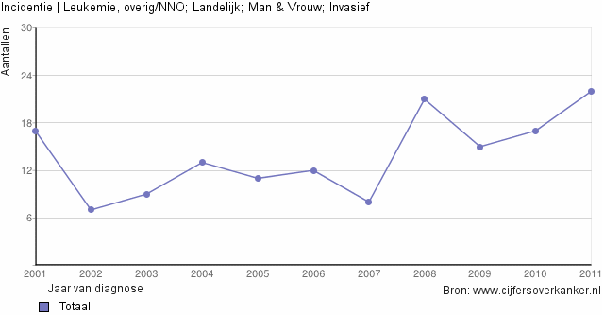
Figure 2: Dutch Leukaemia incidence, note increase after end of 2006.
Digital TV commenced in the USA in 2009. A completely different modulation scheme is employed in the USA known as 8SVB which is a vestigial side-band PAM modulation system which, in addition to the digitised video side-bands, transmits a narrow pilot lock-in carrier which has an amplitude some 10-20dB greater than the rest of the signal.
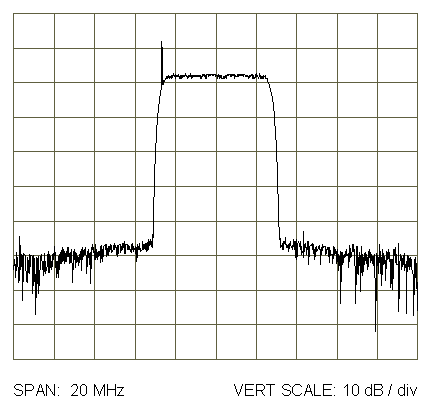
8VSB TV signal power bandwidth spectrum
According to the theory of Lauer (1) a narrow carrier-wave is less disruptive to T-Cell APC binding than a broad flat top pulse emission an example of which is produced by the modulation method used by UK and European DVB(T). 8VSB has a continuous pilot carrier which is about 13dB greater in amplitude than the rest of the emission, possibly this is sufficient to stop the disruption envisioned by Lauer (1).
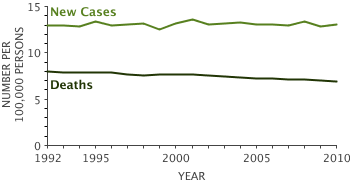
Figure 3: USA Leukaemia incidence rates.
The Leukemic rate in the USA is remarkably flat apart from a transient 6% increase around 1998, possibly this maybe associated with mobile phone technology. At the end of 2009 there is just the hint of another increase possibly as small as 2%. In the UK DVB(T) was phased in gradually with analogue transmitters still running. DAB is also used which has a similar wideband structure. Across the period that these changes happened there was an approximate 23% rise in Leukaemia rates. In the Netherlands there was an enormous 80% increase in Leukaemia rates between 2007 and 2011, analogue TV having been turned off and DVB(T) having been turned on simultaneously.
The difference between the three countries is similar but less marked for NHL rates. Dutch rates are up by about 37%% since 2007 and UK NHL rates have risen by some 18% since 1992 whereas U.S. rates have risen by about 8% with the biggest single change corresponding with the first introduction of digital mobile phone technology.
It is too soon to judge if these trends will be manifest with longer latency cancers but doubtless time will tell.
Discussion
Clearly these results are in very strong support for the theory of Lauer (1) and show that the American 8SVB television system is much safer for the public at large than the UK and European system.
The quantum coherent nature of these types of bio-interaction, see reference (3) and Barnes is also emphasised an proved in another way. 8SVB has been criticised by saying that it is more prone to multipath propagation effects. In essence then this is tantamount to saying it is a less coherent signal. Biological systems are designed to either exploit or reject noise. Intuitively it is expected that highly coherent signals such as DVB(T) will disrupt the immune system more than noisy or random signals.
TETRA is a narrowband signal used for all emergency services communication networks in the UK. There has been a lot of adverse publicity about this system. It would appear that it is due to a specific pulse repetition rate associated with the hand- sets rather than the base station transmitters since all types of cancers in the UK showed a transient decline in incidence rates after TETRA was introduced according to their respective latency periods.
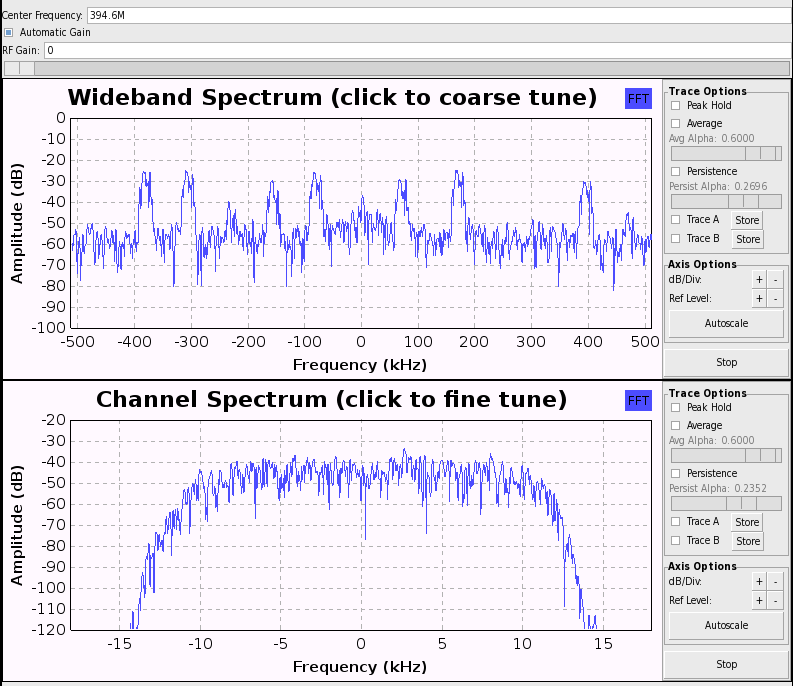
Tetra emission
A TETRA base station emission has a TDMA structure based on a number of narrow frequency hopping carriers which are each no more than 25KHz wide and due to the signal structure will not all be present together. Following Lauer's hypothesis it would seem that emissions form TETRA base stations may in fact be amongst the very few modern radio emissions which are in fact anti-cancer?
Lauer’s theory suggests that systems such as DVB(T) ought only to cause transient increases in the cancer rate. In the UK it would appear that for several cancers the rate is still rising with ‘Lauer style’ transient blips superimposed on a rising background. In the USA most cancer rates with the exception of Thyroid cancer are now in decline. The increase in Thyroid cancer is more or less mirrored across all three countries.
The present author suggests several possible reasons for this:
The delayed effects of Chernobyl are far more significant than previously estimated
The pineal gland is field sensitive and penetration of all other RF technologies completed in the USA several years before the UK
Some other factor causing the background increase, possibly global dimming leading to reduced serum vitamin D
A field sensitive pineal gland results in the gland interpreting RF fields as light and correspondingly reducing nocturnal melatonin. The author has previously shown melatonin deficiency in night lit areas to correlate with increased incidence of several common cancers including Breast, Kidney and Prostate Cancer (16). Further strong support for this comes from the many anecdotal reports of people complaining of difficulty sleeping near mobile phone installations or in hotels with WIFI and DECT phone systems. These are backed up by peer reviewed research, see Oberfield et al ( 17), Santini et al 2003 (18) and Benson 2007 (19).
As RF systems reach a penetration limit the number of cancers due to reduced melatonin will also be expected to saturate and then and only then Lauer’s transient effects (1) will be expected to be visible against a flat background. It may be this process has happened in the USA already where most cancer rates are falling with the exception of thyroid cancer. Interestingly thyroid rates are increasing at more or less the same rate in each of the three countries considered here. It has been proposed elsewhere that this is simply as a result of better detection rates of tiny pre-symptomatic neoplasms, see William et al 2007 (20).
Thus it only remains necessary to explain the differences highlighted here. If RF field induced melatonin reduction is implicated in the mechanism it ought to be possible to correlate slopes in each type of cancer incidence as a result of known changes in background RF exposure against known regression factors for light induced changes. The present author has already examined the effect of night- time light pollution on world cancer rates and obtained regression factors for specific types of cancer, see Table 2 below:
|
Type |
RF |
Low u/v/Vit D |
High night light/melatonin def. |
|
|
|
|
|
|
Bowel |
0.82 |
0.76 |
0.59 |
|
Brain/nervous |
0.74 |
0.64 |
0.56 |
|
Breast |
0.9 |
0.75 |
0.7 |
|
Hodgkin Lymp |
0.81 |
0.83 |
0.56 |
|
Kidney |
0.69 |
0.76 |
0.75 |
|
Leukemias |
0.74 |
0.73 |
0.66 |
|
Lung |
0.58 |
0.7 |
0.6 |
|
Melanoma |
0.64 |
0.28 |
0.24 |
|
Myeloma |
0.79 |
0.41 |
0.39 |
|
Prostate |
0.8 |
0.64 |
0.7 |
|
|
|
|
|
|
Table 2 |
|
|
|
|
|
|
|
|
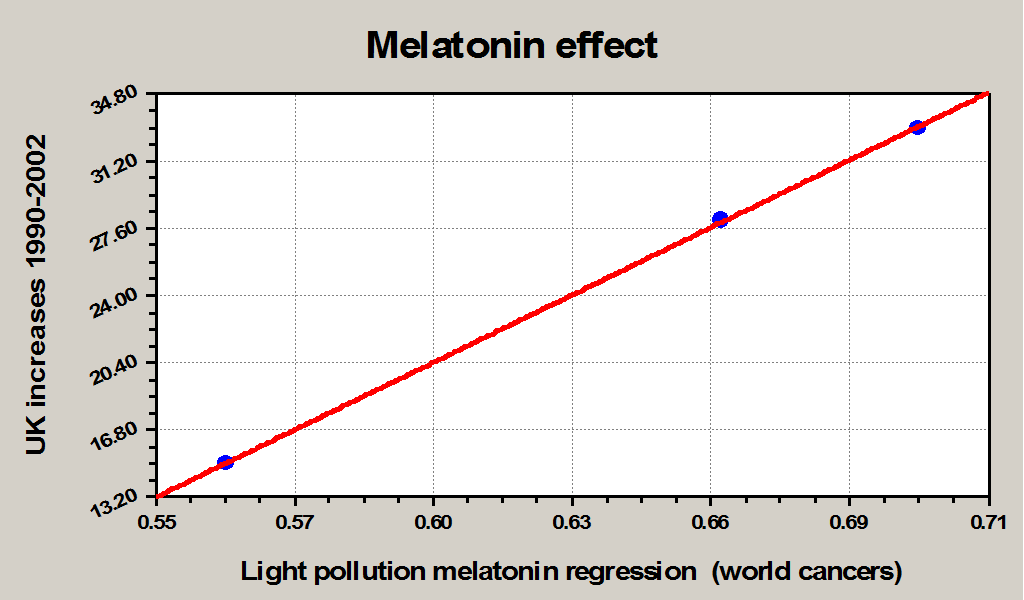
Figure 4.
The proposed regression has been made i.e. plotting the UK increases observed during the period of expanding use of RF technology in the UK 1990 TO 2001 and is plotted above in figure 4 for three cancers in the UK, namely NHL, Leukaemia and Breast Cancer. The regression factor is greater than .99, in other words there is a huge degree of confidence here. A similar plot can be made for just DVB in which case the regression factor is lower .86 but still very significant. Maestroni et al (1987) and Leibmann (2001) (21) have discussed the importance and role of melatonin for the immune system and antibody response. It has been found here and elsewhere by the present author the reduced melatonin has a profound association with breast cancer. This has been discussed with respect to experimentally cultured cells by Hill and Blask (1988) (22) . More recently it has been confirmed that melatonin inhibits the proliferation of all types of cancer cells, see Blask et al (2002) (23) and reduced melatonin aggravates breast cancer ,see Schernhammer and Schulmeister (2004)(24) Thus it would seem another crucial connection linking RF with melatonin reduction and cancer proliferation as a direct result has been discovered in this present work.
It is possible this is augmented by global dimming reducing serum vitamin D levels in parts of the UK, especially under air-lanes. It may also be that this is an effect eventually capable of saturation, the U.S. data certainly suggests this. It ought to be possible to test the saturation effect by comparing US and UK cancer rates for various cancers which appear stable in the US but are still rising in the UK. The stable U.S. age adjusted incidence rate values ought to be at least equal to or higher than the UK values on the basis of the melatonin hypothesis alone but may also show some additional decline depending on the time width of the 'Lauer transients' (1) which to some extent will be determined by the spread of latency periods for each particular type of cancer.
Figure 4 Comparison of U.S. and UK invasive breast cancer cases U.S 1992 -2010; UK 1975-2010
Figure 4 illustrates the prediction exactly. The U.S incidence rate peaked about 1998 at about 135 cases per 100,000 females and is now relatively stable at about 120 cases. The UK rate has continued to grow and is presently 126.3 cases per 100,000. Taking a typical 7 year minimum latency and taking into account the very long switch over period for DVB(T) in the UK it is impossible to say exactly when the UK rate will fall or level out but at least we can predict with some certainly that it should not go that much higher than its present levels. A polynomial analysis, see figure 5, of the existing data tends to suggest that we are probably already at the peak for UK breast cancer, but only time will tell. Thus as the penetration of RF technologies in society saturates then so is expected to cancer rates thus at least the present work predicts that cancer rates will not carry on increasing indefinitely. Thus countries ought to be able to better plan and budget for expected diagnosis numbers and treatment plans into the future.
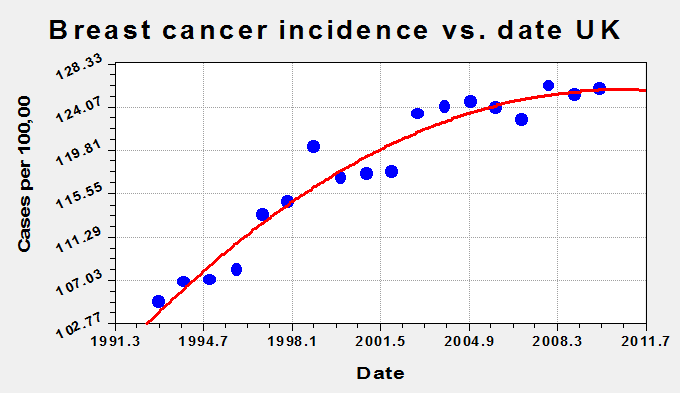
Figure 5: Polynomial fit and extension of UK invasive breast cancer incidence trend since 1993.
The U.S. Leukaemia rate is now relatively stable at about 13+/-1 cases per 100,000 and the UK rate is presently about 11 cases per 100,000. The Dutch rate has recently averaged about 13.5 cases per 100,000 large standard deviation. Most likely this is because Holland was the first country of the three to adopt digital television. Moreover, re-iterating the earlier conclusion, the American 8SVB system is less harmful than European DVB.
Examining the effect of solar irradiance ( vitamin D)
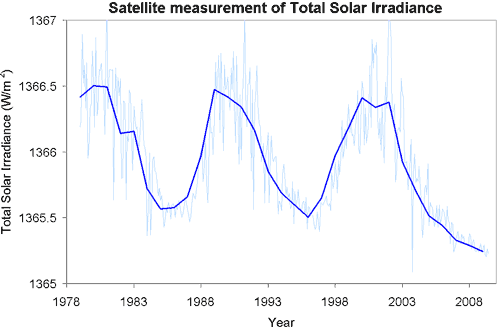
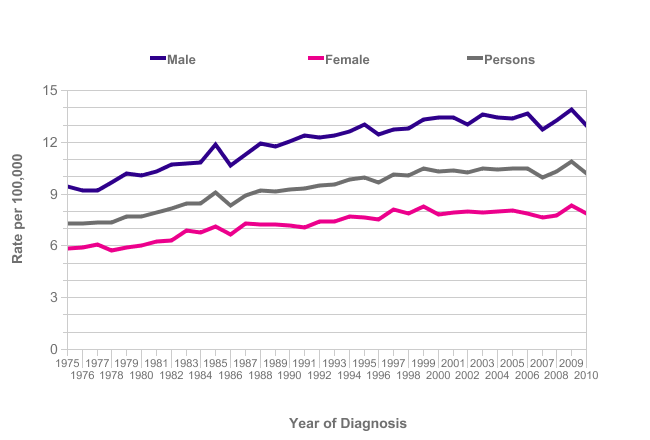
Figure 6 Comparison of solar irradiance changes and Leukaemia trends.
Finally, Leukaemia incidence trends in the UK have been chosen to examine if a discernible effect of solar irradiance can be found superimposed on the other effects discussed above.
Solar irradiance peaked in 1978-79 and thereafter there is a barely discernible flattening of the all persons Leukaemia incidence rate in 1980, which about right given a half year latency period. The next peak in solar irradiance is followed by a tiny trough in the Leukaemia incidence rate in 1992. The final peak in solar irradiance is followed by another tiny trough in the Leukaemia rate in 2002. The changes in solar irradiance are of the order of less than .1% the changes in incidence rate are of the order of .5%. The conclusion is that solar irradiance as a parameter in its own right ( as a indicator of vitamin D status ) is very relevant but that the changes it brings about compared to those existing in the environment from RF radiation are minuscule say less than 10%.
In Britain with its very variable climate, the effects of good summers per se have already been shown elsewhere by the present author (Barnes 2013)(25) to outstrip the effects of total solar irradiance seen here in terms of vitamin D status and cancer.
Conclusions
The above work to some extent supports Lauer's (1) hypothesis the changes in the makeup of the background RF radiation field alter cancer rates in a highly predictive manner due to influence on the immune system, particularly T-cell -APC binding.
The work also establishes an almost incontrovertible argument for the effect of RF on the pineal gland hence reducing serum melatonin levels and promoting cancer.
As RF technologies saturate then so do cancer rates, at least the work establishes that cancer rates will not carry on increasing indefinitely, Thus countries will be better able to budget for expected diagnosis numbers and treatment plans.
The three countries of this study propose further changes in their use of RF technology, 4G, for example, thus further transient changes in cancer rates are to be expected as a result.
Vitamin D status for the Leukaemia trend has only a minimal effect, say 10% compared with other background changes induced by RF radiation as a cancer promoter.
References
http://hal.archives-ouvertes.fr/docs/00/87/72/98/PDF/publiarx.pdf
Smith and Best ISBN 0-460-86044-5)
Semm 1983 http://scholar.google.co.uk/scholar?hl=en&q=pineal+gland+field+sensitive&btnG=&as_sdt=1%2C5&as_sdt
Welker et al 1983 http://link.springer.com/article/10.1007/BF00239209#page-1
Wilson et al 1990 http://efile.mpsc.state.mi.us/efile/docs/13934/0073.pdf
http://onlinelibrary.wiley.com/doi/10.1111/j.1600-079X.1990.tb00901.x/abstract
Liburdy 2007 http://onlinelibrary.wiley.com/doi/10.1111/j.1600-079X.1993.tb00491.x/abstract
http://www.sciencedirect.com/science/article/pii/S0959804900004494
Barnes 2011 http://www.drchrisbarnes.co.uk/HUMPRED.htm
Barnes 2013 http://drchrisbarnes.co.uk/More%20egg%20than%20chicken.html
Barnes 2013 http://www.drchrisbarnes.co.uk/World.htm
Santini et al (2003) http://informahealthcare.com/doi/abs/10.1081/JBC-120020353
Benson (2007) http://www.wifiinschools.com/uploads/3/0/4/2/3042232/joining_the_dots.pdf
William et al (2007) http://www.cmaj.ca/content/177/11/1357.short
Leibmann et al (2001) http://link.springer.com/chapter/10.1007/978-3-642-59512-7_19#page-2
Blask et al http://www.ncbi.nlm.nih.gov/pubmed/11899096
Barnes 2013 http://www.drchrisbarnes.co.uk/latency.html